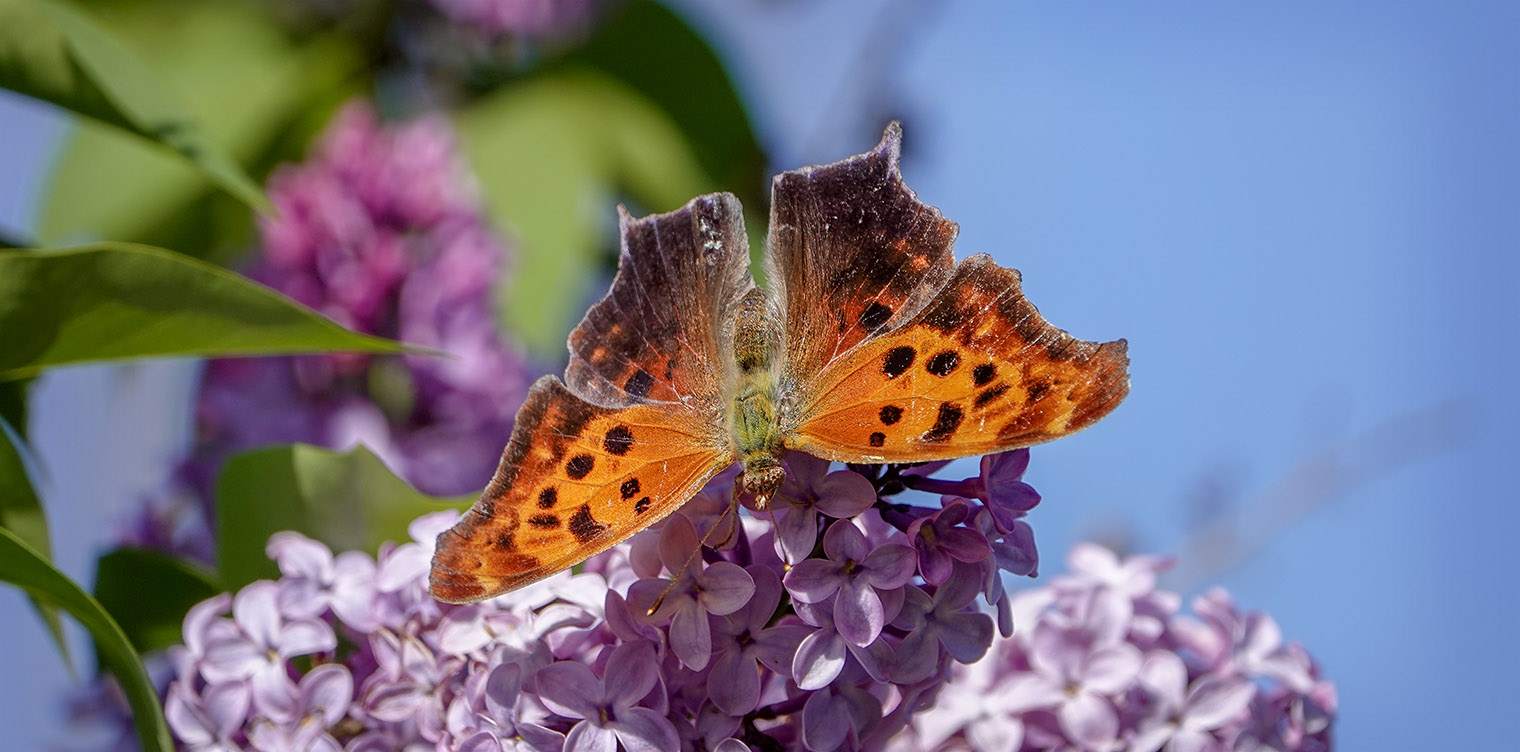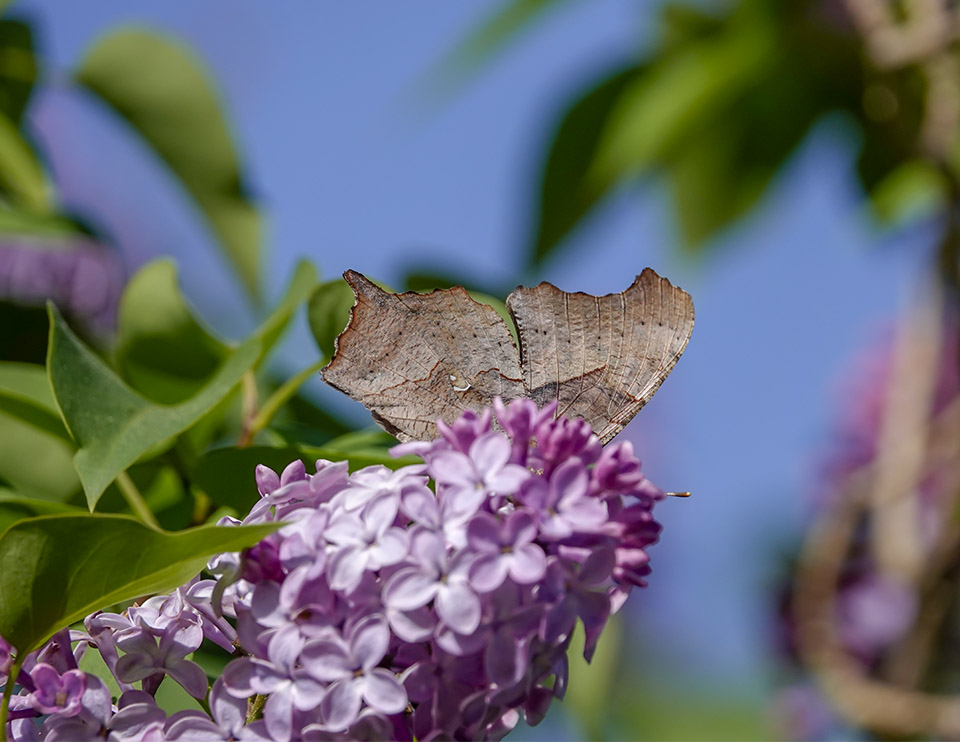Butterflies of the Adirondacks:
Question Mark (Polygonia interrogationis)

The Question Mark (Polygonia interrogationis) is a medium-sized orange and black butterfly that may be seen in the Adirondack Mountains of upstate New York in the summer months. It is a member of the Brushfoot family. [1] The Question Mark is one of the Anglewings, named for the jagged edges of their wings.
The genus name is derived from the Greek word polygonos, which means "many angled." [2] The species name is from the Latin interrogatio, meaning "question." [3] This is a reference to the small silvery question-mark on the hind wing when viewed from below. [4] This butterfly was once known as the Violet-Tip – a reference to the violet sheen on the edges and undersides of their wings. [5] [6]
Question Mark: Identification

From above, the Question Mark is orange or reddish orange with dark spots. From below, this butterfly is light gray-brown and relatively unmarked. [7] The fore wing is hooked. [8] The underside is light brown, with a silvery white mark in the shape of a question mark in the center of the hindwing. One of the identifying characteristics is that this butterfly is the only anglewing with a small black horizontal bar on the fore wing. [9]
The Question Mark has two seasonal forms. [10]
- The hind wing of the summer form (form "Umbrosa") is darker from above; the upper side of the hind wing is almost black. [11] [12]
- The winter form has a longer tail and a largely red-orange dorsal hind wing. [13]
The Question Mark's flight is robust, with slower wing flaps than those of the similar Eastern Comma. [14] The Question Mark is also somewhat larger: its average wing span is 2.5 inches. [15]
Question Mark: Life History
Male Question Marks find females by perching on leaves or tree trunks in the afternoon. [16] [17] Females lay their eggs at singly or stacked under leaves of plants that are usually not the hosts.[18] The light green eggs are keg-shaped and ribbed. [19] The caterpillar must find a host plant. [20] Host plants include nettles, false nettle, Japanese hop, American elm, and hackberry. [21] [22] [23] [24] Caterpillars are spiny and variable in color. [25] [26] [27] They may have four rows of orange spines behind the head. [28]
Adult Question Marks consume tree sap, rotting fruit, dung, or dead animals. [29] Only when these are unavailable will Question Marks visit flowers for nectar. [30] [31] [32] [33] Adults reportedly live for six to twenty days. [34]
Question Mark: Habitat and Range
In terms of ecology, the Question Mark is a generalist.[35] It can survive in a variety of habitats, including deciduous woods with some open space, glades, city parks, orchards, edges and stream sides. [36] [37] [38] This butterfly occurs from the Maritime Provinces west to the eastern foothills of the Rocky Mountains. [39] The Question Marks' range includes all of the eastern US, except for the Florida peninsula. [40]
Question Marks are migratory. [41] Although some Question Marks overwinter in the North, depending on the severity of the winter, [42] [43] many migrate south in the fall. [44] [45] There is also a definite northward migration in the spring, although it is less dramatic. [46] [47] [48] The summer form of the Question Mark emerges and normally flies from June to early August in the north; [49] they lay eggs that develop into the winter form. Winter-form Question Marks appear in late August and spend the winter in various shelters. [50]
Question Mark: Flight
The flight period of Question Marks, as with all butterflies, varies with region and shifts from year to year. Most sources agree that this butterfly is highly variable in abundance. [51] [52] Most sources indicate that there are two generations per year, with the adults overwintering. [53]
- In Wisconsin, there are reportedly two flights of Question Marks. The first generation flies from late June through mid-July. The second generation flies from August into October. [54]
- In Massachusetts, there are also two generations a year. The summer flight is seen between late June and mid- to late August. The Fall slight is seen from late August into October. [55]
- In Vermont, two generations each year are also seen. The summer form flies from late June through August. The winter form flies in September and October. [56]
- In the New York City region of New York State, Question Marks are commonly seen in mid-June, late July, and early October, less common in late May, August, and September. [57]
The flight period and abundance of the Question Mark within the Adirondack Park cannot be determined from data available to date. There are several data sources on which to base estimates of flight periods for butterflies in the Adirondack region. The main sources are verified sightings on Butterflies and Moths of North America (BAMONA) and reported observations on iNaturalist. These materials can be supplemented by an examination of Species Logbooks from the Paul Smith's College Native Species Butterfly House and the Lake Placid Butterfly Count.
- The advantage of iNaturalist is that it is a popular citizen science web site that attracts many observers, in part because it covers both plants and animals and in part because the process of submitting an observation is very easy. The disadvantage is that an individual observation can achieve "research-grade" status by being confirmed by the observer and one additional individual, who may or may not have expertise in that particular taxon
- The advantage of BAMONA is that sightings are verified by regional specialists who are recognized experts. The disadvantage is that there are fewer sighting records for most species, partly because the site covers only butterflies and moths and partly because the process of submitting a sighting is more complicated.
- Both data sets share a common problem of citizen science: reported trends may reflect trends in the number of observers and their willingness to submit reports, not the abundance of the butterfly in question.
In the case of the Question Mark, however, these data sources yield very little insight into this species' flight period, since the number of recorded observations is extremely limited.
- In 2012, a few Question Marks were seen in the Adirondack Park in June and July and in the Paul Smiths VIC Native Species Butterfly House and adjacent Butterfly Garden in June and early August. [58]
- The list of BAMONA-verified sightings for Question Marks in the Adirondack Park includes only five sightings between 2012 and 2019. [59]
- On iNaturalist, there were only six research-grade observations of the Question Mark between 2006 and 2019. [60]
These data suggest that the Question Mark is relatively uncommon within the Blue Line.
References
- Susan Grimm Hanley. Interpretive Naturalist, Paul Smith's College Native Species Butterfly House. Species Logbooks.
- Butterflies and Moths of North America. Species Profiles. Question Mark. Polygonia Interrogationis. Retrieved 12 September 2019.
- Butterflies and Moths of North America. (BAMONA). Sighting records. Question Mark. Polygonia Interrogationis. 6/9/2012; 6/13/2012; 7/5/2014; 7/24/2015; 9/6/2019. Retrieved 12 September 2019.
- iNaturalist. Adirondack Park Sightings. Question Mark. Retrieved 12 September 2019.
- Government of Canada. Canadian Biodiversity Information Facility. Species Bank. Question Mark. Polygonia interrogationis. Retrieved 12 September 2019.
- Massachusetts Butterfly Club. Massachusetts Butterfly Species List. Question Mark. Polygonia interrogationis. Retrieved 12 September 2019.
- Massachusetts Audubon. Butterfly Atlas Species Accounts. Question Mark Polygonia interrogationis. Retrieved 12 September 2019.
- The Butterflies of Massachusetts. Question Mark. Polygonia interrogationis. Retrieved 12 September 2019.
- Kent P. McFarland and Bryan Pfeiffer. Vermont Butterfly Survey. Vermont Center for Ecostudies – Vermont Atlas of Life. Question Mark. (Polygonia interrogationis). Retrieved 12 September 2019.
- Wisconsin Butterflies. Question Mark. Polygonia interrogationis. Retrieved 12 September 2019.
- Montana Field Guides. Question Mark. Polygonia interrogationis. Retrieved 12 September 2019.
- Iowa State University. Department of Entomology. BugGuide. Polygonia interrogationis. Question Mark. Retrieved 12 September 2019.
- Ross A. Layberry, Peter W. Hall, and J. Donald Lafontaine. The Butterflies of Canada (University of Toronto Press, 1998), p. 197, Plates 16 and 21.
- National Audubon Society. Field Guide to Butterflies (New York: Alfred A. Knopf, 1981), pp. 609-610.
- Jim P. Brock and Kenn Kaufman. Kaufman Field Guide to Butterflies of North America (Houghton Mifflin, 2003), pp. 196-197.
- Paul A. Opler. A Field Guide to Eastern Butterflies (The Peterson Field Guide Series, Houghton Mifflin Company, 1992,1998), pp. 50-51, 86-87, 261-62.
- Jeffrey Glassberg. Butterflies of North America (Michael Friedman Publishing, 2002), pp. 144-145.
- James A. Scott. The Butterflies of North America. A Natural History and Field Guide (Stanford University Press, 1986), pp. 284.
- Donald and Lillian Stokes. Stokes Butterfly Book. The Complete Guide to Butterfly Gardening, Identification, and Behavior (Little, Brown and Company, 1991), pp. 68-71.
- Jeffrey Glassberg. Butterflies through Binoculars. The East. A Field Guide to the Butterflies of Eastern North America (Oxford University Press, 1999), p. 117, Plate 33.
- Paul A. Opler and George O. Krizek. Butterflies East of the Great Plains: An Illustrated Natural History (The Johns Hopkins University Press, 1984), pp. 150-151, Plate 26.
- Rick Cech and Guy Tudor. Butterflies of the East Coast. An Observer's Guide (Princeton University Press, 2005), p. 180.
- Thomas J. Allen, Jim P. Brock, and Jeffrey Glassberg. Caterpillars in the Field and Garden. A Field Guide to the Butterfly Caterpillars of North America (Oxford University Press, 2005), pp. 94-95.
